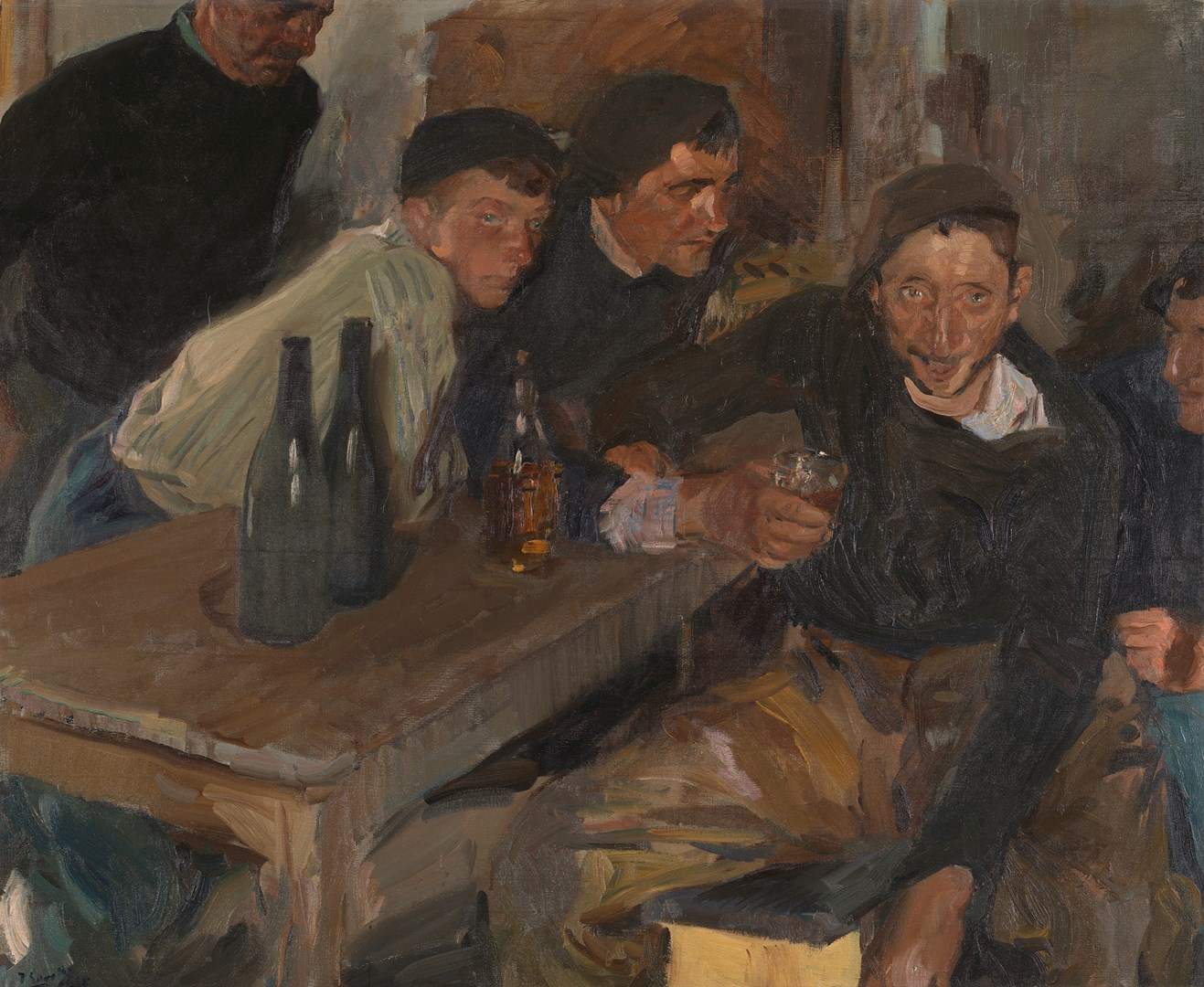For the first time in history, a painting by Joaquín Sorolla (Valencia, 1863 - Madrid, 1923) is entering the collections of the National Gallery in London. It is the work known as El Borracho, Zarauz (“The Drunkard, Zarauz”), from 1910, exhibited for the first time in London in 2019 at the National Gallery itself, on the occasion of the exhibition Sorolla: Spanish master of light, consisting of about sixty works by the Valencian artist and visited by more than 167 thousand people.
The painting was purchased for the sum of 325 thousand pounds (364 thousand euros), thanks to the generous support of a donor, David Leslie Medd. It is a large sketch, executed by Sorolla directly on site at a tavern in Zarauz (in the Basque Country) in the summer of 1910. The drunken man who gives the painting its title is sitting disheveledly on a chair and looking uneasily at the viewer (and in turn is surrounded by four other men who are certainly no better off), holding a glass of cider, a drink popular in northern Spain: the artist’s purpose was to give an idea of the devastating effects of alcoholism. The fact that this is a sketch is clearly evident from the hasty manner in which the artist conducted his scene, quickly applying very thin layers of paint, and economizing on brushstrokes, managing to evoke the contrasts of light and shadow with the meager means that an in situ execution entailed.
The artist, as far as we know, would never have made a finished painting having as its subject a tavern in Zarauz, and probably did not intend to do so either, since this fast-paced painting conveys a sense of intimacy that might not have emerged from a finished painting. And we can also imagine this from the fact that Sorolla did not decide to keep the work in his studio, but exhibited it the following year in an exhibition at the Art Institute of Chicago. The painting is also interesting because it represents the first time since 1900 that the artist returned to dramatic themes: in 1900, Sorolla had painted the bizarre ¡Triste herencia! (“Sad Inheritance!”), which declined his typical seaside paintings in a gloomy key. The scene depicts a group of children guests of the Hospital de San Juan de Dios, a shelter for children with disabilities (“rejects of society: blind, mad, crippled, or lepers”; as Sorolla himself had written), who had arrived on the beach together with a priest: Sorolla was on a beach in Valencia portraying some fishermen at work, but he was greatly affected by the scene: “needless to say, the presence of those poor wretches made an impression on me of deep sorrow. I did not lose the moment, and I asked and obtained from the hospital director the necessary permission to work on the spot and film that scene in its natural state.”
The ¡Triste herencia! earned him a gold medal at the 1900 Paris Expo but also represented the end of the “social” phase of his career, which thereafter veered toward the portraiture and bathing subjects that gave him international fame. The work acquired by the National Gallery is thus of prime importance in the Spanish artist’s career.
“New works help us extend our knowledge of the European painting tradition and enrich the story the National Gallery tells,” said the London museum’s director, Gabriele Finaldi, “so we are delighted that now this extraordinary painting belongs to everyone, including future generations. After the success of the Sorolla exhibition at the National Gallery in 2019, it is great to welcome his first work to the National Gallery’s collections. The subject of a drunkard in a Basque tavern is perhaps uncharacteristic for the artist, but the virtuosity of his brushwork and confident, sketch-like stroke reveal to us a Sorolla of incredible quality.”
"At the time he painted El Borraco, Zarauz," explains Christoper Riopelle, curator of post-1800 art at the National Galery, "Sorolla was considering the commission for the monumental cycle on the people and traditions of his homeland, Visión de España (Hispanic Society of America, New York), on which he would spend the rest of his career. As if he was already preparing it, with this deeply human painting the artist returned to his relationship with Spanish peasant reality and perhaps, and more importantly, to his brilliant use of the indispensable Spanish color: black."
When the National Gallery reopens, when the U.K. confinement to contain the Covid-19 contagion ends, Sorolla’s work will be displayed in Room 41 of the museum, along with works by artists such as Cézanne, Renoir, Monet, Klimt and others.
 |
| London, National Gallery acquires its first painting by JoaquÃn Sorolla |
Warning: the translation into English of the original Italian article was created using automatic tools. We undertake to review all articles, but we do not guarantee the total absence of inaccuracies in the translation due to the program. You can find the original by clicking on the ITA button. If you find any mistake,please contact us.